Related Research Articles

The Sri Lankan civil war was a civil war fought in Sri Lanka from 1983 to 2009. Beginning on 23 July 1983, it was an intermittent insurgency against the government by the Liberation Tigers of Tamil Eelam led by Velupillai Prabhakaran. The LTTE fought to create an independent Tamil state called Tamil Eelam in the north-east of the island, due to the continuous discrimination and violent persecution against Sri Lankan Tamils by the Sinhalese-dominated Sri Lanka government.
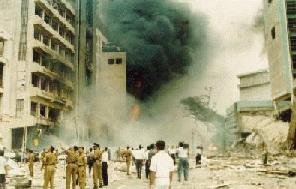
The Central Bank bombing was one of the deadliest attacks carried out by the Liberation Tigers of Tamil Eelam (LTTE) during the separatist civil war in Sri Lanka between the government and the Tamil Tigers.

The Black Tigers was an elite suicide commando unit of the Liberation Tigers of Tamil Eelam (LTTE), a militant Tamil separatist organization in Sri Lanka.

The Sea Tigers was the naval wing of the Liberation Tigers of Tamil Eelam (LTTE) during the Sri Lankan Civil War. It was founded in 1984. The Sea Tigers had a number of small but effective suicide bomber vessels. During its existence it had gained a reputation as a capable adversary for the Sri Lankan Navy. During the civil war, the Sea Tigers had sunk at least 29 Sri Lankan small inshore patrol boats, 20 Dvora-class fast patrol boats, 3 gunboats, 2 Large surveillance command ships, and one freighter.
The 2006 Digampathaha truck bombing, also known as Habarana massacre, was a suicide truck bombing carried out by the Liberation Tigers of Tamil Eelam against a convoy of 15 military buses on 16 October 2006 at Digampathaha, in between the towns of Dambulla and Habarana, in Sri Lanka. The buses were carrying more than 200 sailors from Trincomalee who were going on leave.
Eelam War I is the name given to the initial phase of the armed conflict between the government of Sri Lanka and the LTTE.
The Tamil Eelam Air Force or Sky Tigers was the air service branch of the Divisions of the Liberation Tigers of Tamil Eelam, who used it against the Government of Sri Lanka. They also called themselves the Tamileelam Air Force (TAF). Though the existence of the Sky Tigers had been the subject of speculation for many years, the existence of the wing was only revealed after an attack in March 2007, during Eelam War IV.

Eelam War IV is the name given to the fourth and final phase of armed conflict between the Sri Lankan military and the separatist Liberation Tigers of Tamil Eelam (LTTE). Renewed hostilities began on the 26 July 2006, when Sri Lanka Air Force fighter jets bombed several LTTE camps around Mavil Aru anicut. The government's casus belli was that the LTTE had cut off the water supply to surrounding paddy fields in the area. Shutting down the sluice gates of the Mavil Aru on July 21 depriving the water to over 15,000 people - Sinhalese and Muslim settlers under Sri Lankan state-sponsored colonisation schemes in Trincomalee district. They were denied of water for drinking and also cultivating over 30,000 acres of paddy and other crops. The fighting resumed after a four-year ceasefire between the Government of Sri Lanka (GoSL) and LTTE. Continued fighting led to several territorial gains for the Sri Lankan Army, including the capture of Sampur, Vakarai and other parts of the east. The war took on an added dimension when the LTTE Air Tigers bombed Katunayake airbase on March 26, 2007, the first rebel air attack without external assistance in history.
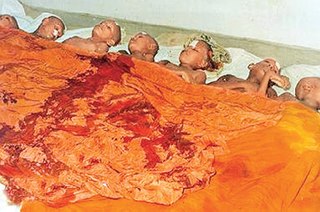
The Aranthalawa massacre was the massacre of 33 Buddhist monks, most of them young novice monks, and four civilians by cadres of the Liberation Tigers of Tamil Eelam organization on June 2, 1987, close to the village of Aranthalawa, in the Ampara District of Eastern Sri Lanka. The massacre is among the most notorious and devastating atrocities committed by the LTTE during the history of the Sri Lankan Civil War, and continues to be commemorated 35 years on.
The Northern Theatre of Eelam War IV refers to the fighting that took place in the northern province of Sri Lanka between July 2006 and May 18, 2009.
The 2008–2009 SLA Northern offensive was an armed conflict in the northern Province of Sri Lanka between the military of Sri Lanka and the separatist Liberation Tigers of Tamil Eelam (LTTE). The battle began with a Sri Lanka Army (SLA) offensive attempting to break through the LTTE defence lines in the north of the island, aiming to conclude the country's 25-year-old civil war by military victory.
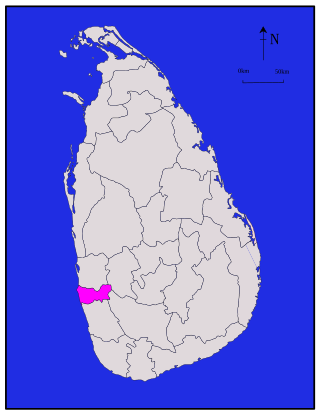
The 2008 Piliyandala bombing was a bombing of a commuter bus carried out on April 25, 2008 in Piliyandala, Sri Lanka, a suburb of Colombo. The bombing killed 26 and injured at least 64, and was the first major attack against civilians on the island since the April 6 Weliveriya bombing that killed Highways Minister Jeyaraj Fernandopulle and national athletics coach Lakshman de Alwis. It was also the deadliest bus bombing since the January 16 attack on a civilian bus at Buttala.
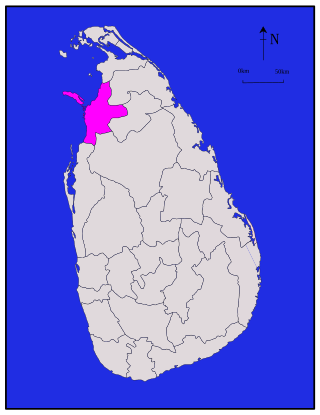
The Madhu School bus bombing, also known as Thadchanamadhu claymore attack, was the bombing of a school bus carried out on January 29, 2008, in rebel LTTE controlled area in Thadchanamadhu in Mannar, Northern province of Sri Lanka. The bombing killed 17 Tamils, including 11 school children, and injured at least 14 more people. The LTTE and NESHOR accused the Sri Lankan Army ’s deep penetration unit for the attack but the Army denied the allegations. This attack was the second attack on a civilian bus in the month of January in Sri Lanka
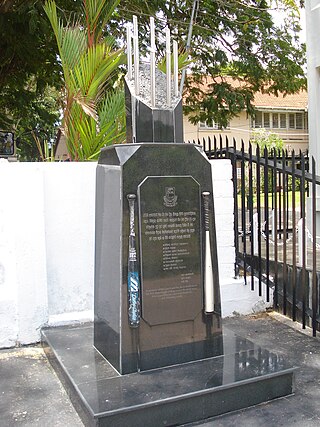
The Fort railway station bombing was a suicide bombing of a commuter train while it was stopped at the Fort railway station, the main station in Colombo, Sri Lanka, on February 3, 2008. The bombing killed 12 civilians and injured more than 100. Killed in the attack were eight school children of D. S. Senanayake College's baseball team and their coach/teacher-in-charge.
The following lists notable events that took place during 2009 in Sri Lanka.
Suicide Bombing was a popular tactic of the Liberation Tigers of Tamil Eelam of attacking enemies to maximize enemy casualties and minimize attacker's casualties.
References
- 1 2 3 4 5 South Asian Terrorism Portal (SATP): Suicide bombings by the LTTE Archived 2015-09-24 at the Wayback Machine , 1987-2007
- ↑ "Sri Lankan suicide bomb kills 13". BBC News . 5 January 2000.
- ↑ Council for Foreign Relations: Liberation Tigers of Tamil Eelam (Sri Lanka, separatists) Archived 2010-05-26 at the Wayback Machine , August 2006
- 1 2 BBC News: Tamil rebels commit suicide, March 11, 2000
- ↑ "Sri Lanka bomb kills 11". BBC News . 27 January 2000.
- ↑ "The fall of Elephant Pass". Frontline, The Hindu. May 12, 2000. Archived from the original on October 17, 2007.
{{cite news}}: CS1 maint: unfit URL (link) - ↑ United States Department of State: Country Reports on Human Rights Practices 2000 - Sri Lanka Archived 2001-06-07 at the Wayback Machine , February 23, 2001
- ↑ "Bomb blast in Sri Lanka". BBC News . 17 May 2000.
- 1 2 South Asian Terrorism Portal (SATP):Prominent Political Leaders Assassinated by The LTTE, South Asian Terrorism Portal (SATP) Archived 2011-06-17 at the Wayback Machine
- ↑ "Timeline: Sri Lanka". BBC News. 2007-05-01. Retrieved 2007-05-30.
- ↑ "EU 'actively considering' Tiger ban". BBC Sinhala. May 19, 2006.
- ↑ "'Rebels sink' Sri Lanka navy boat". BBC News. January 7, 2006.
- ↑ "Sri Lanka explosion 'kills five'". BBC News. 2006-05-01. Retrieved 2007-05-30.
- ↑ "IGomarankadawala: "We need more security say villagers". The Sunday Times. Retrieved 2006-04-30.
- ↑ "Bomb targets Sri Lanka army chief". BBC News. April 25, 2006.
- ↑ "Tamil Tigers warn truce monitors". trans Currents. May 12, 2006.
- ↑ "The Marine battle over 'MV Pearl Cruise II': An Overview". trans Currents. May 14, 2006. Archived from the original on September 11, 2015.
{{cite news}}: CS1 maint: unfit URL (link) - ↑ "E.U. may decide to list LTTE as 'terrorist' by Friday". trans Currents. May 17, 2006. Archived from the original on July 5, 2015.
{{cite news}}: CS1 maint: unfit URL (link) - ↑ "Sri Lanka park landmine kills 8". Cable News Network. Retrieved 2006-03-28.
- ↑ "Government condemns violence against innocent civilians- President". Government of Sri Lanka. May 30, 2006.
- ↑ "The killing of 13 Sinhala workers in the east". Peace Secretariat - LTTE. May 30, 2006.
- ↑ "Incidents involving Liberation Tigers of Tamil Eelam (LTTE)". South Asian Terrorism Portal (SATP). Archived from the original on 2006-06-26. Retrieved 2006-03-28.
- ↑ "United States Condemns Terrorist Attack on Sri Lankan Bus". U.S. Department of State. Archived from the original on 2009-02-02. Retrieved 2006-06-15.
- ↑ "Bomber kills Sri Lankan general". Cable News Network. June 26, 2006.
- ↑ Sengupta, Somini (November 26, 2006). "Sri Lanka Rebels' Critic Silenced by Bullet". New York Times.
- ↑ Rica Roy & Anisa Khan (August 14, 2006). "Lanka blast: Pak envoy safe, 7 killed". NDTV.
- ↑ USA Today: Fighter jets pound suspected rebel camp after suicide bombing kills 95 sailors, October 17, 2006
- ↑ "Failed suicide attack unusual for Sri Lankan rebels known for precision". AP. International Herald Tribune. December 2, 2006. Retrieved 2007-04-07.
- ↑ "Sri Lanka: Bomb Attack On Bus Kills 5". The New York Times. January 6, 2007. Retrieved 2007-05-30.
- ↑ BBC News: Sri Lankan bus blast 'kills five', January 5, 2007
- 1 2 Ganguly, Dilip (January 3, 2007). "Rebels warn of repercussions after raid". The Washington Post. Retrieved 2007-09-22.
- ↑ "Monitors' statement on Sri Lanka killings". BBC News. August 30, 2006. Retrieved 2006-08-30.
- ↑ "SRI LANKA: EU bans LTTE travel in member states". AsiaMedia. Archived from the original on 2006-02-08. Retrieved 2005-02-10.
- ↑ "Bomb Blast in Godagama". Media Center for National Security. Archived from the original on September 28, 2007. Retrieved 2006-01-06.
- ↑ "Bomb hits second Sri Lankan bus". BBC News. January 6, 2007. Retrieved 2007-01-06.
- ↑ "More than 15 civilians feared killed in Bus bomb explosion - Ambalangoda". Ministry of Defence, Government of Sri Lanka. Archived from the original on 2007-10-09. Retrieved 2006-01-06.
- ↑ "Hindu priest gunned down in eastern Sri Lanka, military blames Tamil rebels". The International Herald Tribune. 2007-02-08. Retrieved 2007-02-08.
- ↑ "Hindu priest killed after welcoming Rajapakse". The Peninsula. 2007-02-09. Archived from the original on March 15, 2008. Retrieved 2007-02-09.
- ↑ "LTTE displays trademark brutality". Daily News (Sri Lanka), Government of Sri Lanka. 2007-02-12. Archived from the original on 2007-02-23. Retrieved 2007-02-12.
- ↑ "Tamil Priest who blessed Sri Lanka President shot dead by the LTTE Tamil Tiger Terrorists around 8:45 pm on 7 February 2007". Society for Peace, Unity and Human Rights for Sri Lanka (SPUR). 2007-02-07. Archived from the original on 2007-02-13. Retrieved 2007-02-12.
- ↑ "Hindu priest gunned down in Lanka, military blames LTTE". The Hindu. Chennai, India. 2007-02-08. Archived from the original on September 30, 2007. Retrieved 2007-02-08.
- ↑ "Tamil Tigers kill Hindu priest for garlanding President Rajapakse". Asian Tribune. 2007-02-08. Retrieved 2007-02-08.
- ↑ "Hindu priest killed in Sri Lanka". BBC. 2007-02-08. Retrieved 2007-02-08.
- ↑ "Eight killed in Sri Lanka wildlife park as fighting escalates". The Raw Story. March 10, 2007. Archived from the original on March 17, 2008.
- ↑ "Sri Lankan rebels launch air raid". BBC News . March 26, 2007.
- ↑ Venkatesh, M.R.; Mary, John (2007-04-27). "Tigers take Indians hostage". Calcutta, India: The Telegraph (India). Archived from the original on February 3, 2013. Retrieved 2007-04-28.
- ↑ Ministry of Defence: LTTE kills six civilians - Batticaloa Archived 2014-10-12 at the Wayback Machine , Ministry of Defence, Government of Sri Lanka, April 1, 2007
- ↑ Media Center for National Security: Six More Aid Workers Brutally Murdered by LTTE Archived 2008-01-23 at the Wayback Machine , April 1, 2007
- ↑ "Sri Lanka says rebels kill 6 tsunami project workers". Edinburgh: Scotsman. Reuters. 2007-04-01. Retrieved 2007-04-01.[ dead link ]
- ↑ "Sinhalese aid workers shot and hacked to death by The LTTE". ReliefWeb. 2007-04-02. Retrieved 2007-04-03.
- ↑ Gardner, Simon (2007-04-02). "Sri Lanka says rebel blast on bus kills 15". Swiss Radio. Reuters. Archived from the original on 2007-09-30. Retrieved 2007-04-02.
- ↑ Simon (2007-04-02). "Bomb in bus kills 15 in Sri Lanka". China Daily. AP. Retrieved 2007-04-02.
- ↑ "Sri Lanka says rebel blast on bus kills 16". ABC. 2007-04-02. Retrieved 2007-04-02.
- ↑ Gardner, Simon (2007-04-05). "Sri Lanka says rebels kill 4 farmers, bomb defused". Alertnet. Reuters. Archived from the original on 2007-09-28. Retrieved 2007-04-05.
- ↑ "Seven killed in Sri Lanka bus blast". Times of India. Reuters. April 7, 2007. Archived from the original on April 27, 2007. Retrieved 2007-04-07.
- ↑ "LTTE terrorists attack a civil bus; 8 killed, 25 injured - Vavuniya". Ministry of Defence, Government of Sri Lanka. April 7, 2007. Archived from the original on May 1, 2007. Retrieved 2007-04-07.
- ↑ "Tamils shoot seven villagers dead". AFP. The Australian. 2004-04-13. Archived from the original on 2008-03-15. Retrieved 2007-04-12.
- ↑ "Seven civilians killed in Sri Lanka". AFP. India eNews. 2004-04-12. Archived from the original on September 27, 2007. Retrieved 2007-04-12.
{{cite news}}: CS1 maint: unfit URL (link) - ↑ "Bus blast in Sri Lanka kills five". AP. Chennai, India: The Hindu. 2007-04-24. Archived from the original on 2007-09-30. Retrieved 2007-04-24.
- ↑ "Bomb on Sri Lanka Bus Kills 3 Passengers". Topix LLC. Associated Press. 2007-04-23. Retrieved 2007-04-24.
- ↑ "Tamil Tigers in second air attack". BBC News . April 24, 2007.
- ↑ "Sri Lanka rebels in new air raid". BBC. 2007-04-29.
- ↑ Anusha Ondaatjie, Ed Johnson (2007-05-24). "Sri Lankan Army Bus Bombed; Navy Clashes With Rebels (Update1)". Bloomberg. Retrieved 2007-05-24.
- ↑ Ranga Sirilal, Simon Gardner (2007-05-24). "Sri Lanka rebels attack navy". Reuters. Retrieved 2007-05-24.
- ↑ "Sri Lanka: Blast hits military bus". Cable News Network. 2007-05-24. Retrieved 2007-05-24.
- ↑ "Sri Lanka hit by fresh violence". AFP. Independent Online. 2007-05-28. Retrieved 2007-05-28.
- ↑ "3 killed in roadside bomb blast in Sri Lanka". AFP. NBC News. 2007-05-27. Retrieved 2007-05-28.
- ↑ "Sri Lankan military discovers powerful roadside bomb as violence kills 6". The Associated Press. The International Herald Tribune. 2007-05-27. Retrieved 2007-05-28.
- ↑ "Lankan military defuses powerful roadside bomb". AP. The Hindu. 2007-05-28. Archived from the original on 2007-09-26. Retrieved 2007-05-28.
{{cite news}}: CS1 maint: unfit URL (link) - ↑ "At least 19 people wounded in bomb blast near Sri Lankan capital, military says". The Associated Press. The International Herald Tribune. 2007-05-28. Retrieved 2007-05-28.
- ↑ "At least five killed in bomb blast". Monsters and Critics. 2007-05-28. Archived from the original on 2008-03-15. Retrieved 2007-09-22.
- ↑ "Sri Lanka blast kills 6, wounds 25". CNN. 2007-05-28. Retrieved 2007-05-28.
- ↑ "Roadside bomb kills eight near Sri Lanka military base". AFP. The Raw Story. 2007-05-28. Archived from the original on 2007-09-27. Retrieved 2007-05-28.
- ↑ Shanglin, Luan (2007-07-16). "Senior Sri Lankan official shot dead in east". Xinhua News Agency. Archived from the original on February 13, 2009. Retrieved 2007-07-16.
- ↑ "Senior civil servant shot dead in Sri Lanka". Hindustan Times. Press Trust Of India. 2007-07-16. Archived from the original on September 30, 2007. Retrieved 2007-07-16.
- ↑ "Sri Lanka military: Tamil rebel attack kills 4 village guards, 1 civilian in north". PR-inside.com. AP. 2007-08-20. Archived from the original on 2007-10-07. Retrieved 2007-08-21.
- ↑ Tarique (2007-08-20). "12 killed in northern Sri Lanka". Urdustan Network. DPA. Archived from the original on 2007-09-27. Retrieved 2007-08-21.
- ↑ "Sri Lanka military says Tamil rebel attack kills 4 village guards, 1 civilian in north". Urdustan Network. AP. 2007-08-21. Archived from the original on 2007-09-28. Retrieved 2007-08-21.
- ↑ "Sri Lanka: Blast hits bus, 1 killed". Press Trust Of India. ndtv.com. 2007-09-22. Archived from the original on 2008-03-17. Retrieved 2007-09-22.
- ↑ "Military: 1 killed, several wounded in Sri Lanka bus blast". AP. The International Herald Tribune. 2007-09-22. Retrieved 2007-09-22.
- ↑ "Blast kills 2, wounds 7 in Sri Lanka". AP. The Sydney Morning Herald. 2007-09-22. Retrieved 2007-09-22.
- ↑ "Two civilians, 17 rebels killed in Sri Lanka". Xinhua. webindia123.com. 2007-09-27. Retrieved 2007-09-28.
- ↑ "Civilians killed in northern Sri Lanka explosion". Xinhua. People's Daily Online. 2007-09-27. Retrieved 2007-09-28.
- ↑ Dumlao, Preciosa (2007-09-27). "Bomb Attack Kills Two In Sri Lanka". All Headline News (AHN). AHN Media Corp. Archived from the original on 2008-03-15. Retrieved 2007-09-28.
- ↑ "Suicide bomb attack hits Colombo". BBC News. 2007-11-28. Retrieved 2007-11-28.
- ↑ Jay Shankar: Sri Lanka Bomb Blast Kills 4 in Colombo, Army Says (Update5), Bloomberg.com: Asia, January 2, 2008
- ↑ "Liberation Tigers of Tamil Eelam (Sri Lanka, separatists)". Council on Foreign Relations. 2008-01-11. Archived from the original on 2010-05-26. Retrieved 2008-01-16.
- ↑ Orr, James (2008-01-08). "Sri Lankan minister killed by bomb". The Guardian. London: Guardian Unlimited. Retrieved 2008-01-16.
- ↑ Ramesh, Randeep (2008-01-16). "Tamil Tigers kill 28 with bus bomb". The Guardian. London: Guardian Unlimited. Retrieved 2008-01-16.
- ↑ "Tamil Tigers bomb bus as ceasefire ends". AFP. 2008-01-16. Archived from the original on 2008-01-21. Retrieved 2008-01-16.
- ↑ "23 civilians killed in LTTE-triggered claymore mine explosion in Moneragala District". South Asian Terrorism Portal (SATP). 2008-01-16. Archived from the original on 2008-01-20. Retrieved 2008-01-16.
- ↑ "Uva Province schools closed indefinitely, three school children dead". Daily Mirror. Wijeya Newspapers Ltd. 2008-01-16. Archived from the original on 2008-01-19. Retrieved 2008-01-16.
- ↑ "Sri Lanka: Blast kills at least 24 as rebel truce ends". Adnkronos International (AKI). 2008-01-16. Retrieved 2008-01-16.
- ↑ "Sri Lanka: Blast kills at least 24 as rebel truce ends". IANS. Mangalorean. 2008-01-16. Archived from the original on 2008-04-19. Retrieved 2008-01-16.
- ↑ "Khaleej Times Online - Sri Lankan president urges calm after bomb kills 20". Archived from the original on 2014-10-10. Retrieved 2018-11-22.
- ↑ Seven dead, nearly 100 hurt in Sri Lanka suicide blast: police, hospital, AFP
- ↑ Sri Lanka probes 'bomber offer'
- ↑ "Heartbreak city, thesundayleader.lk". Archived from the original on 2008-05-26. Retrieved 2015-05-27.
- ↑ "Bomb blast outside Sri Lanka capital injures 18". AFP. 2008-02-23. Archived from the original on 2008-02-26. Retrieved 2008-03-12.
- ↑ "Bomb blast in passenger bus in Sri Lanka, two wounded". The Times of India. 2008-02-23. Retrieved 2008-03-12.[ dead link ]
- ↑ "Bomb destroys bus near Sri Lankan capital, 18 hurt". Reuters. 2008-02-23. Retrieved 2008-03-12.
- ↑ "Bomb blast hits bus near Colombo". CNN. 2008-02-23. Retrieved 2008-03-12.
- ↑ Gardner, Simon (2008-02-24). "Suspected suicide blast in S.Lanka, jets bomb rebels". Reuters. Retrieved 2008-03-12.
- ↑ "Three die in Sri Lanka blast". AFP. 2008-02-23. Archived from the original on 2012-10-08. Retrieved 2008-03-12.
- ↑ "Bomber kills self near port in Sri Lanka capital". Reuters. 2008-02-29. Archived from the original on 2008-03-17. Retrieved 2008-03-12.
- ↑ "Suicide Blast Wounds 7 in Sri Lanka". The Associated Press. 2008-02-28. Retrieved 2008-03-12.[ dead link ]
- ↑ "Clashes, bomb blast kill 16 in northern Sri Lanka, military says". International Herald Tribune. The Associated Press. 2008-03-02. Retrieved 2008-03-12.
- ↑ "Bomb Hidden in Flowerpot Explodes in Sri Lanka, Killing 1". AP. FOX News Network. 2008-03-10. Retrieved 2008-03-12.
- ↑ Gardner, Simon (2008-03-10). "Blast in Sri Lanka capital kills one". Reuters. Retrieved 2008-03-12.
- ↑ "Many dead in Sri Lanka bus blast". BBC News . April 25, 2008. Retrieved 2008-04-25.
- ↑ "Tamil Tigers Suspected in Rush-Hour Bus Bombing in Sri Lanka". Voice of America . April 25, 2008. Archived from the original on April 30, 2008. Retrieved 2008-04-25.
- ↑ "Many dead in Sri Lanka bus blast". BBC News . May 16, 2008. Retrieved 2008-05-16.
- ↑ "Deadly taxi bomb targets police in Sri Lanka". CNN . May 16, 2008. Retrieved 2008-05-16.
- ↑ "Bomb rocks busy Sri Lankan train". BBC News . May 26, 2008. Retrieved 2008-05-26.
- ↑ "Tamil Arrested in Sri Lanka Train Bombing". The New York Times. September 4, 1996.
- ↑ "Sri Lanka commuters hurt by bomb". BBC News. 4 June 2008.
- ↑ "Deadly blast hits Sri Lanka bus". BBC News. 6 June 2008.
- ↑ "Polgolla bomb kills two". BBC News. 6 June 2008.
- ↑ "Policemen die in S Lanka attack". BBC News . May 16, 2008. Retrieved 2008-06-16.
- ↑ "Over 20 Killed including Maj Gen Janaka Perera in LTTE suicide attack - Anuradhapura". Archived from the original on 2008-10-13. Retrieved 2008-10-07.
- ↑ "Columns - Situation report" . Retrieved 2008-10-12.
- ↑ "Senior Surveyor dies in bomb explosion" . Retrieved 2008-10-12.
- ↑ (AFP via The Melbourne Age)
- ↑ "Sri Lanka 'suicide bomb kills 14'". BBC News. March 10, 2009.